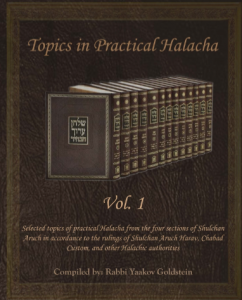
This Halacha is an excerpt from our Sefer
Buy here
Standing for Chazaras Hashatz:[1]
Some Poskim[2] rule the entire congregation is to stand throughout Chazaras Hashatz.[3] [Many Poskim[4] conclude that one is to follow this opinion. Some Poskim[5], however, rule that one need not heed by this opinion and may sit down during Chazaras Hashatz. Practically, the widespread Sefaradi custom is to sit[6], and so is the custom of many Ashkenazi communities.[7] The widespread Chabad custom is to sit, although there are individuals who are stringent to remain standing.[8] The Rebbe was accustomed to sit after Kedusha and would stand up slightly prior to Modim and remain standing.[9] Even those who are accustomed like the stringent opinion to stand, may sit if they are feeling sick or weak.[10] Even those who are accustomed to sit, it is forbidden for them to sit within four Amos of one who is still Davening Shemoneh Esrei, including not to sit within four Amos of the Chazan.[11]]
|
Summary: The widespread custom in many communities is to be lenient and sit throughout Chazaras Hashatz, however some are particular to stand as require some opinions. According to all, it is forbidden to sit within four Amos of the Chazan or of one who is still Davening Shemoneh Esrei.
|
______________________________________________________________
[1] Admur 124:7; Rama 124:4; Ketzos Hashulchan 61:8; See Piskeiy Teshuvos 124:10; Halacha Berurah [Yosef] 124:4
[2] Opinion in Admur ibid and Rama ibid; Hagahos Minhagim Tirana; See Rambam Tefila 9:3 “Everyone stands and hears the blessings” [See Biur Hagr”a 124; Beis Avi 7:115; Yaskil Avdi 2; Piskeiy Teshuvos and Halacha Berurah ibid for explanation of Rambam and why it is not cited by Rama ibid]; All Poskim in coming footnotes who conclude like this opinion.
Stringency or letter of the law: Some Poskim learn that even according to this opinion it is a mere stringency and not required from the letter of the law. [See Or Gadol Rosh Hashanah 4:9, Beis Avi and Yaskil Avdi ibid] However, from the wording of Admur ibid and other Poskim brought below who follow this opinion, it is clear that it is required from the letter of the law and not just a mere stringency. See Halacha Berura ibid
[3] The reason: Being that the congregation is concentrating and listening to the prayer of the Chazan, and one who hears is like one who says it, and as if he is Davening himself [therefore the listeners are to stand just like the Chazan]. [Admur ibid; Biur Hagr”a 124:4] It is for this reason that the Tekios within Chazaras Hashatz of Musaf Rosh Hashanah are called Meumad/Standing, as the congregant stands during Chazaras Hashatz. [Admur 124:7 in parentheses]
Other opinions: Some Poskim rule that the reason one is required to stand for the Tekios Meumad is because even the listeners are included in the juxtaposition of the requirement to stand by Shofar and since the Tekios Meumad is the fulfillment of the main Mitzvah of Shofar, therefore also the listeners must stand. [Radbaz 1:25; Mor Uketzia 585; Elya Raba 585:2; Mateh Yehuda; Machazik Bracha 585:1; Erech Hashulchan 585:1; Kaf Hachaim 585:2] This reason is clearly negated by Admur in 585:1-2; 124:7 and 592:7 which explains that the main Mitzvah is fulfilled by Tekios Meyushav.
[4] Leket Yosher p. 27 that so was custom of Terumos Hadeshen; Halachos Ketanos 2:80 “So is the logical ruling”; Menoras Hamaor 3:111; Hagahos Hatur; Shalmei Tzibur p. 137; Makor Chaim 124 of Chavos Yair; Kesher Gudal 18:12; Chesed Lealafim 124:3; Kaf Hachaim Falagi 16:53; Ben Ish Chaiy Teruma 10; Kaf Hachaim 124:24; P”M 124 M”Z 2 “So was the old custom, however today due to our great sins people sit and talk”; M”B 124:20 quotes P”M ibid; Aruch Hashulchan 124:9 that so is the final ruling and so is the custom of all G-d fearing Jews; Shulchan Hatahor 124:9 “It is proper to stand if one is able”; Kitzur SHU”A 2:1 “One who can easily stand should do so”
[5] All Poskim in coming footnotes who bring custom of sitting as a correct custom in Halacha; Custom of Shmuel in Yuma 87b, brought in Halachos Ketanos ibid, Or Gadol Rosh Hashanah 4:9; See Beis Avi and Yaskil Avdi ibid
[6] Yechaveh Daas 5:11; See however Halachos Ketanos ibid “The Sephardim are all accustomed to stand” and so rule all the Sephardi Poskim ibid
[7] Halachos Ketanos ibid “The Ashkenazi community of Verona is accustomed to sit”; Levushei Mordechai Tinyana 91 “So is custom in our provinces” however he himself would stand; Toras Chaim Sofer 124:9 “Majority of the world is accustomed to be lenient”; Darkei Chaim Veshalom 178 “He would sit after Hakeil Hakadosh”; Piskeiy Teshuvos 124:10 that today many are lenient to sit by Chazaras Hashatz
[8] Ketzos Hashulchan ibid footnote 21 records the stringent opinion and then states “at the very least one is to stand for Hakeil Hakadosh”
[9] Hiskashrus 944
[10] Leket Yosher ibid that so did Terumos Hadeshen; Ben Ish Chaiy ibid; Kaf Hachaim ibid; Aruch Hashulchan ibid
[11] P”M 124 M”Z 2; M”B 124:20; Ketzos Hashulchan 22:8 in name of M”B ibid; See Admur 102:2



Leave A Comment?
You must be logged in to post a comment.